Wind and Water Power – Then and Now
(with a few additional remarks by the editor-in-chief)
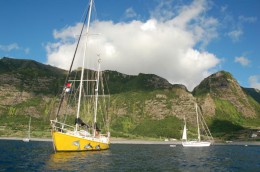
It was early afternoon and we were in Flores, just nearing the end of one of the scenic walks for which the Azores are famous. We had started that morning, leaving Mollymawk anchored in the bay behind us, and we had now been walking, at a leisurely pace, for most of the day – along a road, up a track, along a footpath, and past a lake which had eleven waterfalls pouring endlessly into it.
“Such a lot of water going to waste,” I said.
“Yes, it makes you want to rush up and turn it off,” Mummy agreed.
Living on a boat, we are used to having to be very sparing with water.

Steve, our friend, was the one who had recommended the walk to us, and he had walked bouncily along beside us keeping a wary eye on Poppy, who snuffled around in the leaves and refused to come when she was called. Steve didn’t trust dogs. There are lots of fierce guard dogs in the Azores, and he carried a knife so that he could slit their throats if they attacked him.
But now we were all coming home and Steve had got used to Poppy. He was holding onto the tip of her lead and making gruff, unnecessary commands at her. Poppy obeyed meekly. She was tired out after all her running around. Steve decided some dogs were okay after all.
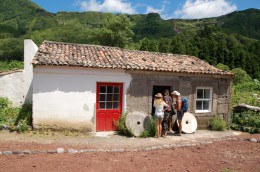
So, we came round a corner, and we found ourselves facing a little, unremarkable looking building, which was nevertheless emitting a strange splashing, rumbling noise.
When we came round the front of the building it was pretty clear what it was. Two huge millstones stood either side of the doorway, one cracked and the other clearly worn down by years of use. Inside, the little building was filled with the sound of another pair of stones spinning around at a surprisingly high speed.
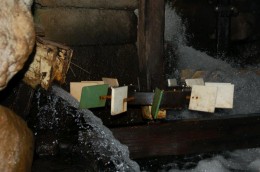
The mill was grinding corn into flour, and it was powered by a very small stream, probably running down from the lake which we had seen. The mill was built on top of the stream. The miller was a woman. She showed us the little stream, and then she took us under the house, where the stream was running, and we could see water pouring onto a wheel. The wheel was lying on its side in the water, with its axle sticking upwards. It was like a cart wheel, but it had a big spade-shaped vane on the end of each spoke. The water caught the vanes and pushed the wheel round and round, and when it turned it moved the axle. The axle went up through the floor of the mill and through the middle of one of the mill stones.
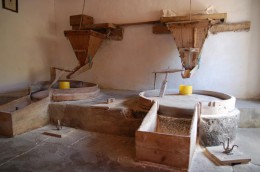
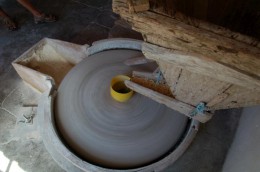
The miller took us up the steps again and we went into the mill. There were just three small rooms, and in the first one there were two pairs of stones which sit one on top of the other. The bottom stone of each pair is fixed to the floor. It is called the bed stone, because it just lies there. The other stone was attached to the top of the turning axle, so it spun round and round. This one is called the runner stone. In the middle of the runner stone there was a hole, and the maize was trickling down into the hole, where it was ground to flour between the two stones.
It seemed to me that the woman running the mill didn’t actually have to do anything. The mill ran itself. She told us that she didn’t live in the mill anymore but she used to, twenty years ago. Nowadays the mill is little more than a tourist attraction but twenty years ago it was still used by the local people to grind maize for their cornbread and cornmeal for their chickens. Later we met a man who grew up there when his father was the miller.
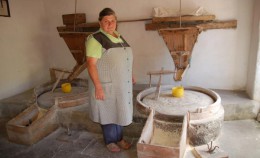
This particular mill was a horizontal mill. It is the simplest type of mill, and the first kind to be invented. Mills like this were probably in use all across Europe until laws were passed, in mediaeval times, making it illegal for people to grind their own flour. They had to have it ground by the lord of the manor where they lived. Horizontal mills were reintroduced into poor countries like Spain and Portugal, after the law was abolished. But they never came back into use in England because England had already been industrialised, and the peasant people no longer had any land on which to grow wheat. The land had all been claimed by a few rich men and was being farmed efficiently, using machines.
Watermills run back to quite a long time ago. The first people to use them were the ancient Greeks, about 260 years BC. Of course this was not the first time someone thought of making flour and baking bread from it. Before this people had been manually grinding grains for thousands of years, first just by rubbing grain between two big stones, and then by using a big hand quern (a pair of very small stones) with a wooden handle. After that they probably used slaves, and horses and donkeys, to turn bigger stones.
Vertical watermills are much more complicated then horizontal mills. They have a much bigger wheel, and instead of being on its side in the water it sits upright. It is often attached to the side of the building instead of being under it. Instead of having vanes these wheels have pockets. The water is usually made to pour from a place above the wheel, and it fills up the pockets, each in turn. The weight of the water in the pockets pushes the wheel round.
The axle of the wheel fits into a couple of gears which turn the drive the right way up again, so that it can turn the stones in just the same way as in the older type of mill. Vertical water mills need a much bigger supply of water then the horizontal kind. They need a big pond of water. Usually the water comes from a stream or river, but sometimes mills are powered by the tide. Mummy used to live in a tide mill. (If you should happen to want to see one – the world’s only working tidemill is at Eling, near Southampton, in England.)
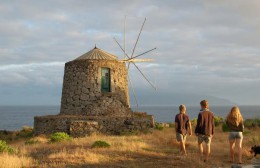
Of course, needing a constant supply of water to grind your grain isn’t always practical. Even in a place as wet as the Azores archipelago, in some places streams and rivers can be either seasonal or simply non-existent. The island of Corvo for instance has no streams. Here we saw another kind of pre-industrial power source, in the form of three windmills which are lined up on the sea shore.
The workings of the windmill are very similar to that of the vertical watermill – except that they are upside down! The wheel is a huge propeller that is turned by the wind. Instead of having lots of vanes it has some long slender arms – sometimes just four, sometimes six or eight. The arms each carry a sail. The sail catches the wind just like water on the water wheel, and pushes the wheel round. And just as on the horizontal watermill, the axle is horizontal, so it needs to have a series of gears to make the drive vertical so that it can pass through the middle of the grinding stones.
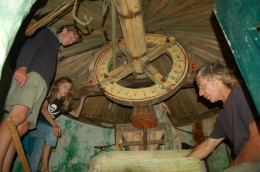
Wind power was being used to sail ships long before it was used to drive mills. Sailing was invented thousands of years ago. The earliest record of a windmill is in England, in 1185. Some historians suggest that crusaders returning from the wars in the Holy Land might have brought the idea back with them, because we know that the Arabs were using wind power to lift water to irrigate their fields. However the Arab machines were not mills, and they did not look like the wind-driven machines that we know. They were actually rather like a horizontal watermill, because they span round like tops. So far as we know this type of wind machine was never used anciently in Europe either for lifting water or for milling.
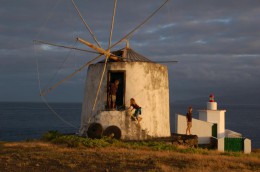
In the few days that we were anchored of Corvo there was plenty of wind – almost too much to safely stay there – but unfortunately none of the windmills were making use of it. They were all out of working order, and clearly hadn’t been used for years. Two have been disembowelled and are being used as stores, but one is still fitted with the old machinery; so there is a possibility that it will be revived, if only as a museum piece and tourist attraction.
Why is it that people have stopped using wind and water power to do their work? In the past windmills and watermills were not only used to grind wheat and maize but also to make paper, to prepare wool for weaving, to power the looms which wove the cloth, to drive huge hammers and saws, to grind metal, and to perform many other repetitive industrial chores. Wind and water power were also used to lift water for irrigating fields and orchards, and in fact we have seen many “mills” in Spain which were still used until quite recently for this purpose, and we saw one which is still in working order.
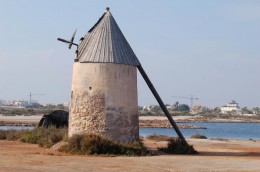
In England people had more or less stopped using watermills by the Second World War Steam power had been invented and it gradually took over, being more powerful and more reliable. Industry became bigger. Lots of small mills was less efficient than one huge mill, and grinding flour with huge metal rollers powered by a diesel engine or was more efficient than grinding flour with stones powered by the fickle breeze or by a stream.
But is efficiency the most important thing in life?
Now we have coal-fired power stations and nuclear powered stations, which generate electricity – which is what everything is run by, now. Every factory, office, shop and home depends on electricity.
It seems that the only thing windmills and watermills are useful for now is sight-seeing. Some of the few remaining ones have been repaired for us to look at. Some have even been restored and are grinding corn again, but usually they are only doing this so that people can see, as realistically as possible, what it was like in the “old days”. In fact, nowadays we think of watermills and windmills as very scenic and picturesque – but not as efficient viable sources of power.
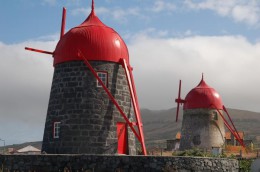
Perhaps we need to change our way of thinking about life. Power stations are not picturesque, they are very ugly. And they are harmful to the environment. They are using up our resources and dirtying our atmosphere. Windmills and watermills, by contrast, are harmless.
Windmills harness the wind, which is something that will always be here and will never run out. Windmills use it, without damaging or removing it, and then they put it back exactly as it was. There is no waste. And there is no smoke or other pollution coming out of a windmill.
The same applies to watermills. A stream could go through a hundred watermills on its way to the sea, and yet it would remain the same. Despite all the energy taken out of it, it would not change. It could still go through a hundred more watermills. A stream has an endless supply of energy, because the energy is not taken from the water itself, but the gravity of it falling gently across the sloping land.
If civilization carries on in the direction that it is going – forever expanding – then eventually it will explode. And if there are any survivors after this collapse then we will not be able to depend on electricity. We will have to go back to grinding grain and lifting water and doing all of our other chores without just being able to press a button.
If we don’t want civilisation to explode then we need to do something about it now. Not just talk about it, and moan about it, and say what ought to be done, but actually do it – ourselves! One thing is to stop wasting electricity, which uses up resources and poisons our world. And if we do need to use electricity, then we must only use clean electricity, created without making pollution. Windmills and watermills can both be used to generate electricity.
Not that we have to go around building stone buildings with cloth sails again. We have progressed since then, and our modern “windmills” are efficient stream-lined machines, with flat plastic blades moulded into the perfect shape. Our modern watermills have progressed too. They make more efficient use of the water travelling along a stream, but they still don’t change it.
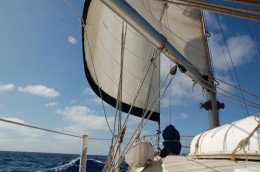
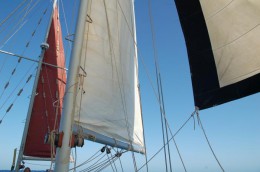
Many governments are being a bit slow about switching to wind and water power and other clean sources of electricity, but we do not have to wait for them. We can do it ourselves.
Our yacht is (almost always) entirely wind-powered. She is driven by the wind, and she has a wind generator on top of her mizzen mast. This, with the help of four solar panels, provides all the electricity ever used aboard our boat. Apart from the usual lights, and other minor things such as the music player, we have been known to have three computers running at the same time, and Caesar has his one on almost all of the time. We also run power tools, a sewing machine, and even a DC welder. (The welder uses so much power that unless the wind is pumping, and the batteries are really sparking, we generally have to run the engine while the machine is actually in use.)
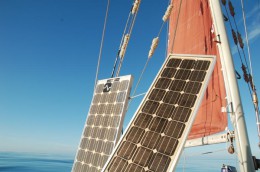
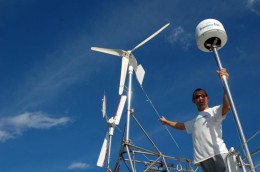
If you live in a house than it is perhaps a little harder to be energy-independent and to stop using electricity made from coal or oil or nuclear power- but it is definitely not impossible.

These website have information which might help you if you would like to make your own energy from the sun or the wind :-
http://www.clean-energy-ideas.com/solar_panels.html
This site explains the difference between solar panels for heating water and photovoltaic solar panels. Whichever kind you are interested in there is plenty of information on the web. All you need to do is google : eg.”photovoltaic solar panels uk”.
http://www.mdpub.com/SolarPanel/
If you want to have a go at building your own photovoltaic solar panels this site will tell you how. We haven’t tried it – yet… so we don’t know whether it’s really feasible.
http://www.builditsolar.com/Projects/frugal.htm
Scroll down the page to find links to lots of interesting and useful solar projects, such as a DIY solar water heater.
http://www.ecotricity.co.uk/windenergy/index.html
This page of ecotricity’s website explains why the UK ought to be using wind power as its principal source of energy. Did you know that the Spanish province of Navarra is now almost exclusively wind and solar powered? And yet we read that the UK gets more wind! It’s time the Brits did their bit for the planet.
http://www1.eere.energy.gov/windandhydro/small_wind_system_faqs.html
Information provided by the US Department of Energy for Americans thinking of installing a wind turbine on their land. It contains advice about assessing the likely power output based on the location, in the US, of the property.
http://mdpub.com/Wind_Turbine/
From the man who gave us DIY solar panels (above) – a DIY wind turbine.
http://www.builditsolar.com/Projects/Wind/wind.htm
More useful info from Build It Solar, including recommended reading on the subject of DIY wind power and dozens of links, some to companies which sell wind turbines or turbine kits, and others to websites featuring DIY plans. One contains instructions on how to turn an old washing machine into a wind generator!
(Fellow yotties please note: – This site is not really for us. Almost all of these wind machines are way too big to fit on a boat.)
http://www.squidoo.com/diy-plans-for-wind-generators
More DIY wind generator advice, from someone who has built 10 of the things in his time.
http://www.uk-energy-saving.com/energy_saving_tips.html
If you can’t produce your own electricity and your province, state, or nation isn’t totally wind, wave, or solar powered yet, the best thing you can do is to use less of the dirty stuff. Here you’ll find a few suggestions for cutting your electricity use (and your bill). Google “energy saving tips” and you’ll probably find a lot more.

Hiya Roxanne!
Your article was great! I really enjoyed reading it!
From Beth
Good article